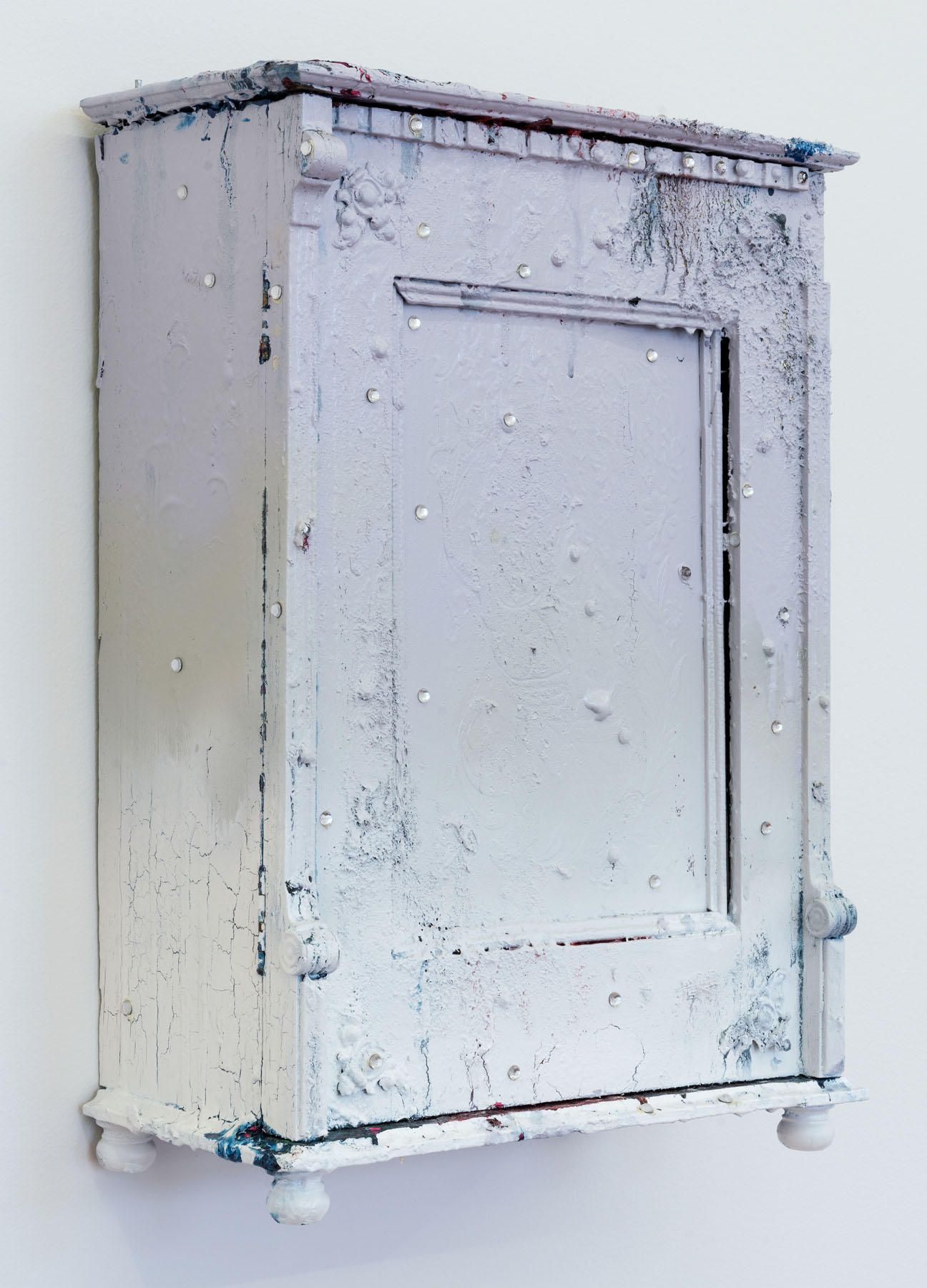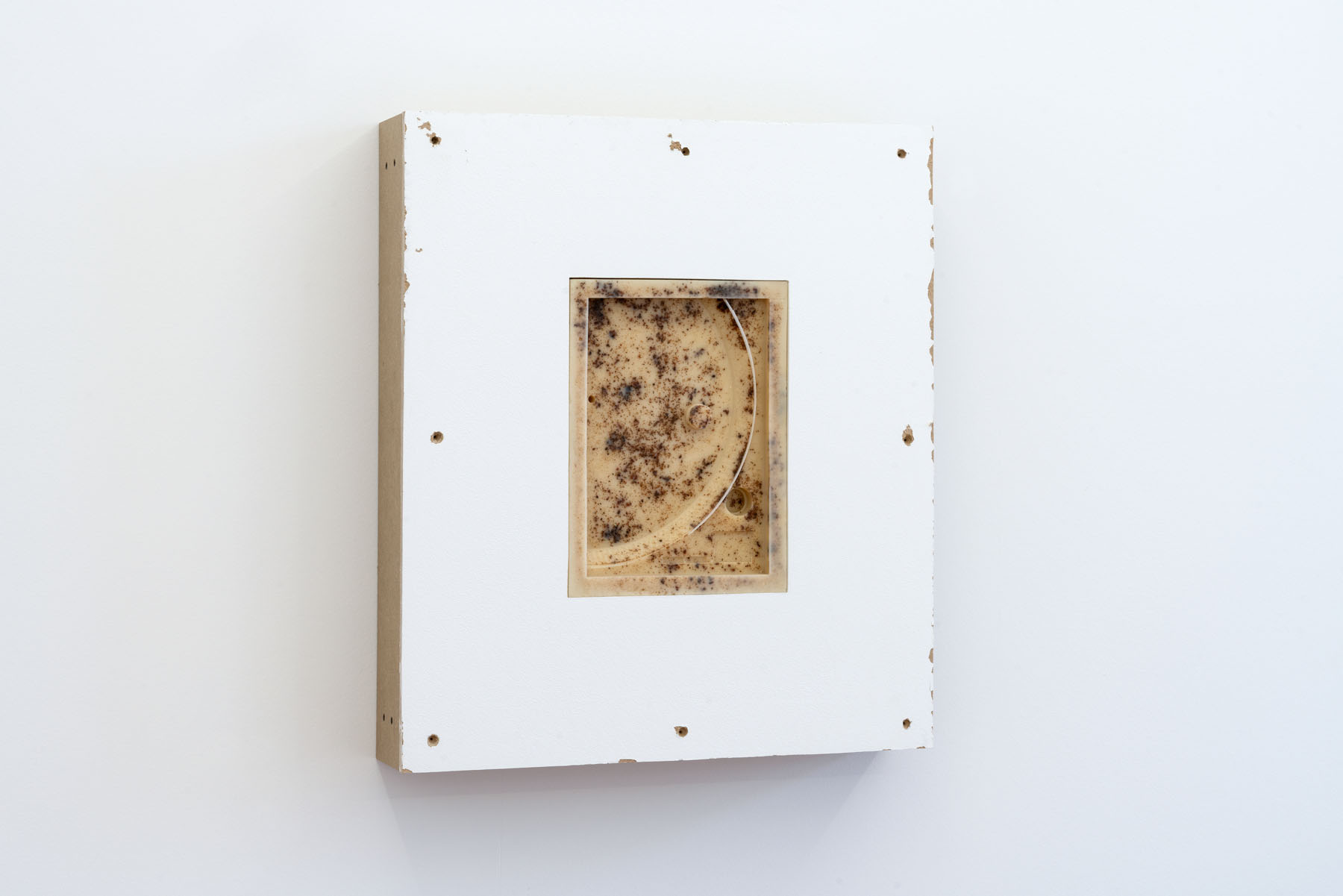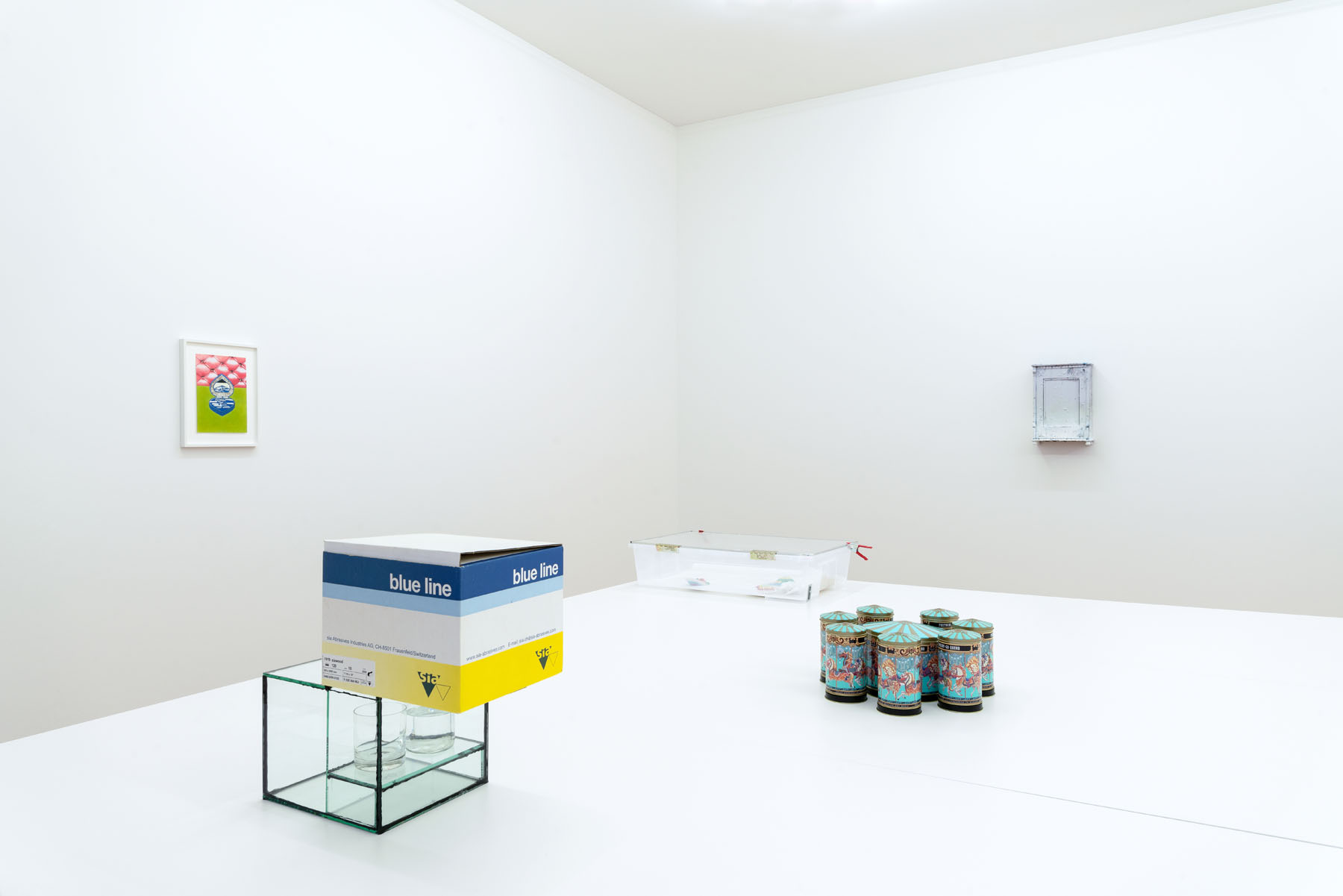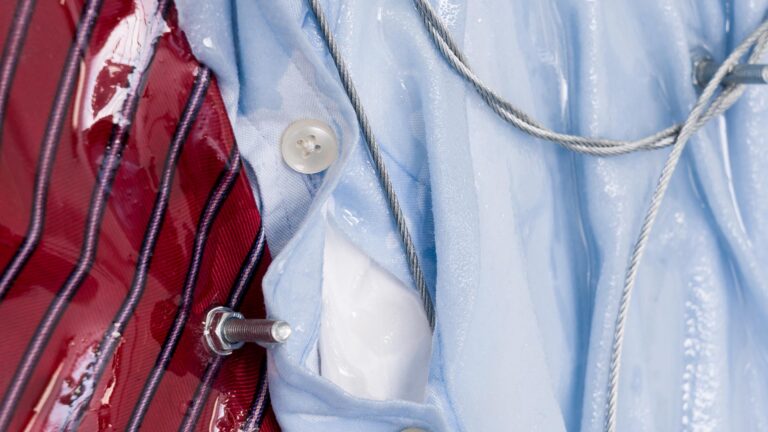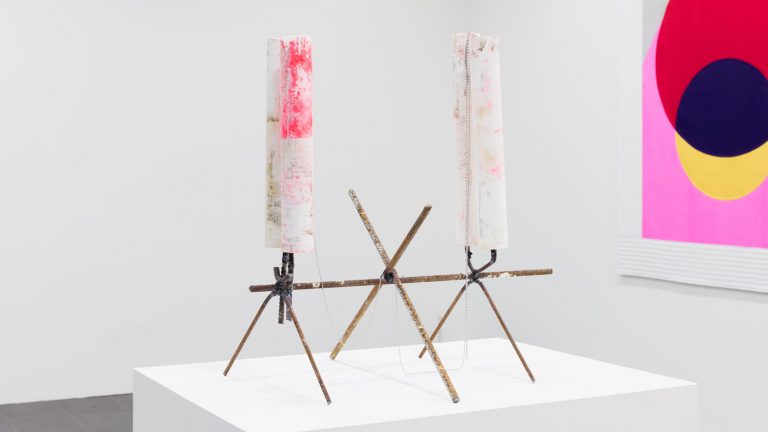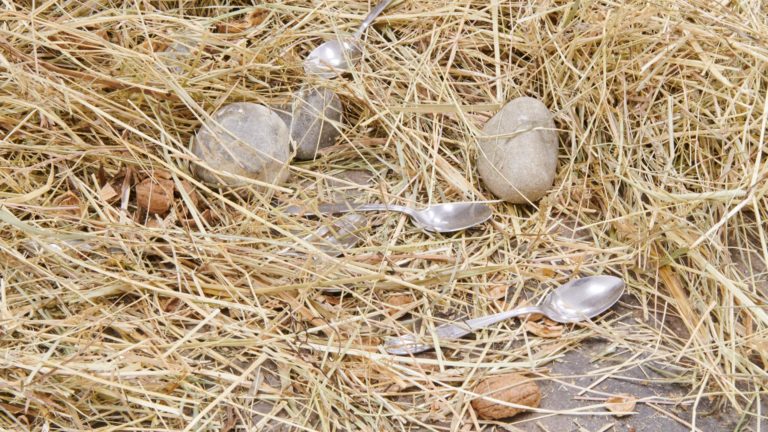Artists: Rosa Aiello, Camille Aleña, Adelhyd van Bender, Karin Borer, Patricia L. Boyd, Manuel Burgener, Lisa Herfeldt, Samuel Jeffery, Maggie Lee, K.R.M. Mooney, Kaspar Müller, Phung-Tien Phan, Vaclav Pozarek, Marta Riniker-Radich, Julia Scher, Richard Sides, Davide Stucchi, Sergei Tcherepnin, Angharad Williams, Amy Yao
Exhibition title: KASTEN
Curated by: Cédric Eisenring & Luca Beeler
Venue: Stadtgalerie, Bern, Switzerland
Date: March 28 – July 11, 2020
Photography: CE / all images copyright and courtesy of the artists and Stadtgalerie, Bern
1
SAMUEL JEFFERY
Untitled, 2017
PVC, acrylic primer, insulating tape
30.5 x 47.5 x 28 cm
Untitled, 2019
PVC, acrylic primer, vintage car motor oil
30.5 x 50.5 x 32.5 cm
Two containers, formed from cut, heated and bent PVC sheets, are part of an ongoing series of works by Samuel Jeffery. Each is placed on a plinth. The container-like objects are treated with various materials and coated with hardware store paint. Seemingly manufactured according to precise standards, they nevertheless differ from one another in detail. The outer surface of Untitled (2019) has been treated with motor oil used for vintage classic engines. Much like a car, the box-works could be imagined as carriers of sorts, transport for unidentified transmissions. The motor oil and its mechanical associations only accentuate the containers’ state of inertia and give them a slightly nostalgic, military-industrial feel. Offsetting a longing for the bygone with the anticipation of pending action, these works look both backwards and forwards.
2
RICHARD SIDES
The slowest plane crash ever recorded in history, 2020
1-channel HD, monitor, concrete, plywood
120 x 50 x 25 cm
The slowest plane crash ever recorded in history—the title suggests an event so drawn out as to defy the event-focused, technical logic of media. Plywood covers the front face of Richard Sides’s work. One face broken up into four parts only allows indirect views from the face into the inner space of the concrete structure. The faces move toward the back in perspective, thus drawing the eye slowly into the interior toward a flickering light source—in a hypnotizing way, like watching an unstoppable, eternally dragged-out event. The title of the work is taken from a You-Tube commentary on the Prince Andrew interview, in which he tries for fifty minutes to wriggle himself out of the Epstein scandal.
3
K.R.M. MOONEY
Accord, A Chord I, 2016
Wood composite, vinyl, folded aluminum, steel, spray millet, cast silver, whistle, solder
Two parts: 45.7 x 35.6 x 7.6 cm; 53.3 x 45.7 x 7.6 cm
Composite board form the outer shell of Accord, A Chord I, initially installed in a residential shed that formerly served as a mechanic’s workshop, the work consists of two small, box-like sculptures placed directly on the floor. Incorporating materials with generative qualities or structures that shift with environmental factors, obscured within their interior are seeds and plants—some cast, others dried—that are used by humans and animals alike, normalizing alliances between materials with multiple associations. Linking participatory actors such as existing systems and their adjoining surroundings with sculptural form and behavior, K.R.M. Mooney’s works occupy intermediary positions between abstract, autonomous and the site-specific.
4
AMY YAO
Weeds, 2015
Artificial flowers, silicone, artificial nails
30.5 x 43 x 18 cm
Silk flowers, bones, plastic fingernails and nuts fill the volume of a transparent protective cover for pillows. These materials mark spaces where a specific domesticity and industrial production meet. The preserved and ever-blooming silk flowers are confronted with a logic of circulation and production in which waste is not a by-product, but a basic prerequisite. In this sense, Weeds also illustrates the extent to which the rigid separation of the categories “natural” and “artificial” is associated with a particular form of production.
5a / 5b
ROSA AIELLO
Resolve (tritone inward), 2020
2 motion-activated loudspeakers
Dimensions variable
Detecting movements in their vicinity, the sensors of the two small devices function as electrical switches. Motion activates
the integrated speaker causing each device to play a different chord: the first part of a two-part tritone. The devices are arranged in a particular order in the room. The first chord creates a feeling of anticipation or tension. The second erodes or fulfills the expectation. The minimal variances reinforce to an even greater degree the conditions in the space that are altered by the devices and show how the configuration of the room can impact lived experience.
6
LISA HERFELDT
Slithering, 2019
Acrylic glass, nylon fabric, polyester fleece
23 x 67 x 23 cm
These tongue-like objects perform synthetic affects. Transparent cubes of acrylic glass serve as containers for otherwise disembodied tongues.
7
MAGGIE LEE
Alfred Hitchcock Microchipped Pigeon, 2020
Packing tape, flock fiber, acrylic, photocopy
33 x 27.9 x 2.5 cm
Brown packing tape on canvas. Three photographs serve as labels for this visual package: a low-resolution print of a child’s antique bedframe, a cropped magazine image of a gift of flowers and a dove with a microchip on its head. Alfred Hitchcock Microchipped Pigeon can be interpreted as a suggested title for a fictional (and non-existent) film by Alfred Hitchcock. In attempting to describe the mechanisms of tension in his films, Alfred Hitchcock coined the term “MacGuffin.” The MacGuffin more or less describes any object or creature in a film that triggers or advances the action without serving another functional purpose. The externally controlled behavior of a microchipped pigeon or an unwanted gift could assume this function within the narrative implied here.
8a
MARTA RINIKER-RADICH
A Frame of Cast Iron Lace, 2018
Color pencil and pencil on paper
29.7 x 21 cm
8a
MARTA RINIKER-RADICH
The Vapors, 2019
Color pencil and pencil on paper
29.7 x 21 cm
The tiny vanity cases depicted in the series of drawings by artist Marta Riniker-Radich address the privileged aspect of personal care that allows us to isolate ourselves, to think about ourselves and only about ourselves and no one else. The cases condense domestic space, with its promise of providing protection from the outside world, creating in the process an ever-threatening negative pressure. The meticulous technique of colored pencil drawings only reinforce the latent feeling of tense silence. The space of the box is often the starting point for Marta Riniker-Radich to formulate her drawings: both enclosed and infinite, like a magic box with a false bottom.
9
KASPAR MÜLLER
Ohne Titel, 2020
Wood, metal, coins, lacquer, acrylic paint, glitter, rhinestones
46 x 16 x 32 cm
As is evident, this object served as a historical medicine chest while it has not necessarily been stripped of its original function. In working with the object, the artist has only altered its status. As a box coated in layers, Ohne Titel is suggestive of various temporalities: the artist’s time in the studio, the time of the material, historicism. A seductive patina that serves any desire for authenticity but remains permanently unfulfilled at the same time.
10
PATRICIA L. BOYD
SL-1200MK2 Face: Christian Andersen, 10/25/19-12/21/19, 2019–2020
Used cooking fat, wax, damar resin, particle board
63 x 54 x 10 cm
SL-1200MK2 Face: Christian Andersen, 10/25/19–12/21/19 is part of an ongoing series of works by artist Patricia L. Boyd.
The works in the series go through various stages, forming links with the physical and logistical architecture of an institution
or gallery: the negative forms, cast from a mixture of used cooking fat, wax and damar resin, are embedded on site into
the walls of the exhibiting gallery or institution. The cast is held in place by particle board that is integrated into the gallery
wall. Like a prosthesis, the piece of particle board is not only attached to but also alters and reconfigures the work. After the
closing of the exhibition, the negative form and plate are removed and converted into a free-standing sculpture (box), which
can now be circulated and shown in any number of subsequent exhibitions. The exhibition dates and name of the location
where it was exhibited first is then added to the work’s title. The various negative forms are from components of two objects
Patricia L. Boyd purchased at the liquidation sale of a San Francisco-based tech company: a Herman Miller Aeron office
chair and a Technics SL–1200 record player.
11
MANUEL BURGENER
Untitled, 2017
Glass, cardboard, LED, alcoholic spirits
43.5 x 25.5 x 44 cm
The volume of the glass cube on the bottom is derived from that of the shipping package of Sia Abrasives sandpaper. The cardboard box is positioned in such a way that it defies all structural logic; opening it up is the only way to release the glass structure that supports it. Found inside is a bottle with self-distilled gin and glasses—a situation visitors can activate.
12
CAMILLE ALEÑA
Fortnum and Mason, 2017
9 music boxes, Arduino board
41ø x 17 cm
Fortnum and Mason consists of music boxes from the eponymous British luxury department store. Imprinted with a horse carousel, the nostalgic product is both a biscuit tin and music box. For Camille Aleña’s work the original melodies and rotary motors have been retained, transformed and rearranged into a ghostly choreography that repeats every six minutes.
13
ANGHARAD WILLIAMS
Wet flannel on my side like the saddle on a horse, 2016–2020
Paper, air-dried clay, acrylic ink, hinges, storage box
55 x 18 x 78 cm
Angharad William’s plastic boxes are micro scenes. Oscillating between makeshift display cases and material storage boxes, they create certain reading contexts for the texts that accompany them: stories that feed on despair, vulgarity and seduction. The objects illustrate collages of absent characters – remnants taken from the stories. The box presented at the Stadtgalerie is part of this ongoing series.
14
DAVIDE STUCCHI
Her Mess, 2019
Carton, various unloaded items
38 x 13 x 6 cm
Her Mess, 2019
Carton, various unloaded items
38 x 13 x 5 cm
Her Mess, 2019
Carton, various unloaded items
38 x 13 x 4 cm
Her Mess, 2019
Carton, various unloaded items
38 x 13 x 3 cm
“Personal effects is a mind-boggling way to phrase belongings. I love word plays, especially when English is not our native language so we take ‹meanings› / etymology even more literally—at least I do. It exposes the limits of one’s cognitive abilities, and the labour to keep up with everyday flows. […] Personal effects, titles of my works such as Her Mess or Neck Laced are a lovely way to situate the pieces on a timeline of actions. It definitely feels the works conjure an absent user. The many signifiers point to their class/societal position. To me it came across distinctively bourgeois. It’s incredible to grasp the residue people leave in our lives, especially how immaterial it is mostly. Scents, body areas once touched by lovers and friends, specific times of the day. I don’t know how this happened, but every now and then for years I turn my head to see the time and it is 4:40pm, or around that hour. I used to wait for a really good friend of mine, who I was deeply obsessed and in love with, to meet and have a snack after school. We don’t talk to each other anymore.”
Davide Stucchi in correspondence with Bruno Zhu
15
SERGEI TCHEREPNIN
Baby Box #2 (Ringing Rock Stages of Production), 2013
Steel, copper, transducer, amplifier, iPod
18 x 18 x 18 cm
The object Baby Box # 2 (Ringing Rock Stages of Production), featuring a copper tongue and a steel box, is a sound sculpture that works simultaneously as a loudspeaker and an instrument. The box belongs to a group of sound system-based works, characters that encourage interaction. The material configurations and their specific sounds allow viewers to navigate around using their ears and bodies.
16
JULIA SCHER
For fairness (Pink and Black box), 2019
3-print, paint, cotton glove
3 x 9.5 x 9.5 cm
Artist Julia Scher’s box is a hybrid: deeply rooted in everyday regular boxes, it nevertheless points to the hybridity of future conditions. It could provide support, protection, and nourishment for a range of functions and activities for future entities. Its construction and materiality shifts between the domestic (storage, preservation, cupboard and table) and the terrestrial: it is made out of minerals, cellulose, natural adhesives and colour. Inside the box is a white cotton glove, but it could basically host anything one might deem necessary. Based on a source code, the design is reproducible with any 3D-printer: the code merely suggests an initial state from which to derive new functions and meanings.
A hybridity of theme- a unique artwork
A hybridity of making- a formal articulation that celebrates the uniqueness of any making
A hybrid of assembly- a combination usually called montage or collage
It seems built for one hand but can suggest the expression of multiplicity.
Can (anything) work together…as one?
Julia Scher
17
KARIN BORER
Danger, 2018
Charred wood
43 x 6 x 190 cm
The dark surfaces of the ceiling-mounted wooden box have been burned and carbonized—a traditional technique to prevent insect attacks. The box has slits on the bottom and sides. These form links between different habitats. Karin Borer’s work aims to generate intersecting gazes: human and non-human. Here she plays with aspects of the box as addressing the registers of visibility and non-visibility.
18a
DAVIDE STUCCHI
Personal Effects, 2019
Cardboard, adhesive tape
83 x 15 x 15 cm
18b
Infusion d`Iris, 2019
Plexiglass, perfume packaging
23 x 17 x 17 cm
19
PHUNG-TIEN PHAN
Lil Emo, 2019
Toy trucks, photographs in wooden display cases with sliding glass panels
Each 60 x 80 x 9.5 cm
The work Lil Emo by artist Phung-Tien Phan consists of six commercial display cases. Photographs of male, international pop stars, actors, musicians, models and writers appear as reified rites of passage: a specific collection representative of certain fragile ideas, memories, concepts and masculine imagery, and also of a certain biography and its social background. The images are juxtaposed with a collection of toy trucks of primarily German companies and brands. They suggest different ideas about cultural identification, masculinity and coming of age. Beyond the aspect of adopting things for personal usage, both collections refer to larger industrial and infrastructural links. The objects are arranged into a single letter inside each display case; together they form the title of the work: Lil Emo.
20
ADELHYD VAN BENDER
Untitled (1–14), 1999–2014
Cardboard, metal handles and rivets, adhesive tape, varying contents
Each about 50 x 37 x 25 cm
Folders and boxes serve as physical structures in Adelhyd van Bender’s work, whose cryptic systematization employs graphic and scientific means, repetition and variation. Against the backdrop of impending self-destruction during the Cold War, Adelhyd van Bender developed an obsessive fascination with atomic radiation that preoccupied him up to his death in 2014. Repeatedly appearing in his countless drawings are geometrical diagrams reminiscent of atomic models, orders of the universe or mystical models – like the Sefiroth of the Kabbalah. These also include missile-like structures, maps of alleged nuclear power plants in Germany, plans for the city of Moscow and radiation warning signs. The status of the contents inside the fourteen commercial and variously patterned storage boxes remains unclear. The A4 sheets, often copied multiple times and in some cases showing slight variances, are most likely original material the artist intended to work on further. The boxes also contain official documents – some of which also reappear in drawings – mail-order catalogs, magazines and other material.
21
LISA HERFELDT
Lilac Licker 3, 2019
Acrylic glass, nylon fabric, polyester fleece
45 x 23 x 11 cm
22a
VACLAV POZAREK
Geschlossen, 2016
Wood, painted
75 x 71 x 100 cm
22b
VACLAV POZAREK
Wandrelief halboffen, 2002
Wood, painted
44 x 72 x 57 cm
Terms such as geschlossen [closed], halb offen [half-open], offen halb offen halb leer [open half-open half-empty], or offen [open] are recurring titles or additions to titles in the work of Vaclav Pozarek. They describe an object’s state. The often reappears in Vaclav Pozarek’s sculptures, drawings and photographs. Even the crates used to transport his works, made by the artist himself, look like stand-alone works. The sculptural boxes create space—both visible and invisible. They require no pedestals and most are themselves support structures. Vaclav Pozarek also frequently creates display cases, shelves and entire exhibition arrangements.
KASTEN, 2020, exhibition view, Stadtgalerie, Bern
KASTEN, 2020, exhibition view, Stadtgalerie, Bern
Amy Yao, Weeds, 2015
K.R.M. Mooney, Accord, A Chord I, 2016
KASTEN, 2020, exhibition view, Stadtgalerie, Bern
Richard Sides, The slowest plane crash ever recorded in history, 2020
Richard Sides, The slowest plane crash ever recorded in history, 2020
Samuel Jeffery, Untitled, 2017; Untitled, 2019
Rosa Aiello, Resolve, (Detail), 2020
KASTEN, 2020, exhibition view, Stadtgalerie, Bern
KASTEN, 2020, exhibition view, Stadtgalerie, Bern
Marta Riniker-Radich, A Frame of Cast Iron Lace, 2018
KASTEN, 2020, exhibition view, Stadtgalerie, Bern
KASTEN, 2020, exhibition view, Stadtgalerie, Bern
KASTEN, 2020, exhibition view, Stadtgalerie, Bern
Kaspar Müller, Ohne Titel, 2020
KASTEN, 2020, exhibition view, Stadtgalerie, Bern
Maggie Lee, Alfred Hitchcock Microchipped Pigeon, 2020
Angharad Williams, Wet flannel on my side like the saddle on a horse, 2016 – 2020
KASTEN, 2020, exhibition view, Stadtgalerie, Bern
KASTEN, 2020, exhibition view, Stadtgalerie, Bern
Patricia L. Boyd, SL-1200MK2 Face: Christian Andersen, 10/25/19-12/21/19, 2019–2020
KASTEN, 2020, exhibition view, Stadtgalerie, Bern
Lisa Herfeldt, Slithering, 2019
Rosa Aiello, Resolve, 2020
KASTEN, 2020, exhibition view, Stadtgalerie, Bern
Davide Stucchi, Her Mess, 2019
KASTEN, 2020, exhibition view, Stadtgalerie, Bern
Marta Riniker-Radich, The Vapors, 2019
Julia Scher, For fairness (Pink and Black box), 2019
KASTEN, 2020, exhibition view, Stadtgalerie, Bern
KASTEN, 2020, exhibition view, Stadtgalerie, Bern
KASTEN, 2020, exhibition view, Stadtgalerie, Bern
Manuel Burgener, Untitled, 2017
KASTEN, 2020, exhibition view, Stadtgalerie, Bern
Adelhyd Van Bender, untitled (1-14), 1999 – 2014
Adelhyd Van Bender, untitled (1-14), (Detail), 1999 – 2014
Adelhyd Van Bender, untitled (1-14), (Detail), 1999 – 2014
Adelhyd Van Bender, untitled (1-14), (Detail), 1999 – 2014
Adelhyd Van Bender, untitled (1-14), (Detail), 1999 – 2014
KASTEN, 2020, exhibition view, Stadtgalerie, Bern
Lisa Herfeldt, Lilac Licker 3, 2019
Vaclav Pozarek, Geschlossen, 2016
Vaclav Pozarek, Wandrelief halboffen, 2002
KASTEN, 2020, exhibition view, Stadtgalerie, Bern
Pung-Tien Phan, Lil Emo, 2019
KASTEN, 2020, exhibition view, Stadtgalerie, Bern
Davide Stucchi, Infusion d’Iris, 2019
Karin Borer, Danger, 2018
Davide Stucchi, Personal Effects, 2019

















